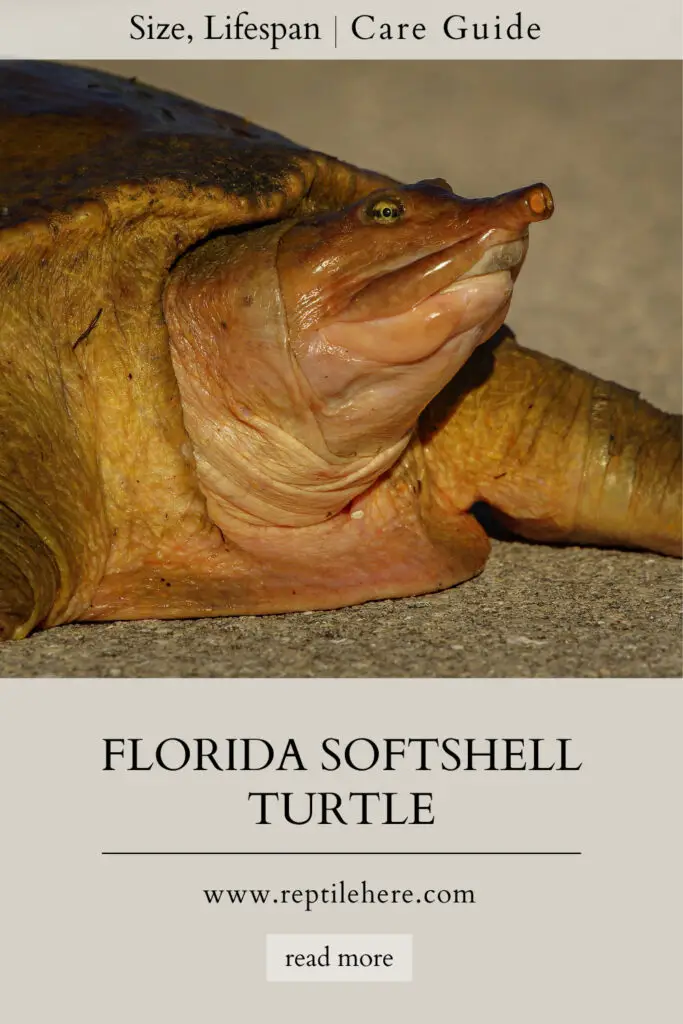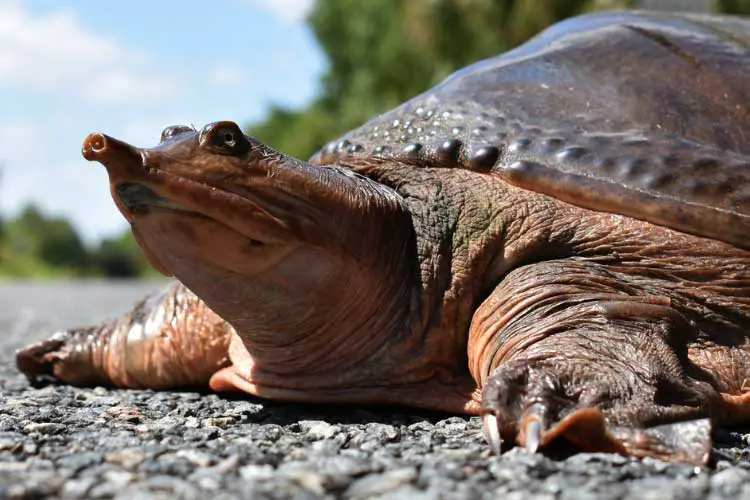Florida Softshell Turtle: Size, Lifespan, Care Guide
Florida softshell turtle belongs to the unique family of softshell turtles—it lacks the characteristic hard shell that defines all turtles. Nonetheless, it can make a good pet if you meet all its special requirements and accord it good care.
Florida softshell turtle proper care includes a 75 to 100-gallon enclosure with swimming space, basking spot, heat source, and UV light. This turtle is primarily carnivorous and feeds on insects, worms, mollusks, etc. With proper care, this turtle can live for 20 to 30 years.
In this guide, we’ve discussed everything you need to know about Florida softshell turtles including size, lifespan, proper habitat, the right diet, temperament, and common health issues.
Florida Softshell Overview:
Contents
- Common name: Florida Softshell Turtle, Softshell Turtle
- Scientific name: Apalone ferox
- Average size (adults): 8 to 24 inches (females), 6 to 12 inches (males)
- Distribution: Native to various regions of the U.S. including Georgia, South Carolina, Mobile Bay, and Florida
- Lifespan: 20-30 years
Can You Keep Florida Softshell Turtle as A Pet?
You can keep a Florida softshell turtle as a pet but you first need to understand its special needs and how to take good care of it.
For instance, you should provide it with a proper habitat that mirrors its natural habitat.
You should also feed it with the right diet. All these are essential to ensure your softshell will stay happy and healthy.
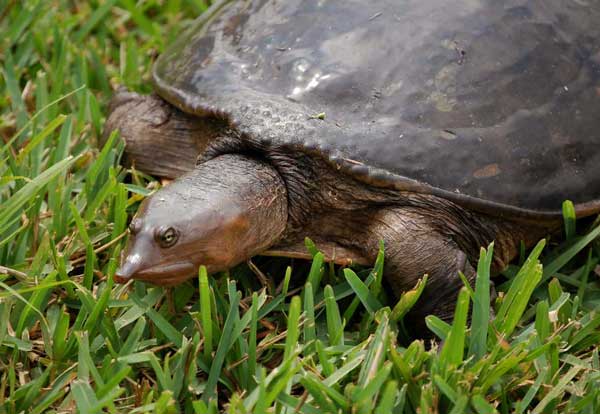
Proper care will also extend your pet’s lifespan by up to 35 years or more!
Before owning this turtle, you should check if it is legal to keep it in your region to avoid getting to the wrong side of the law.
Collecting this turtle from the wild without a permit is also illegal in most regions, so you’d want to get your pet from a reputable pet store or a reputable breeder.
Florida Softshell Turtle Tank Setup
Probably one of the most important steps in taking good care of your pet turtle is providing it with a comfortable living space.
To do this, you’ll need to come up with a tank setup that mimics its natural habitat.
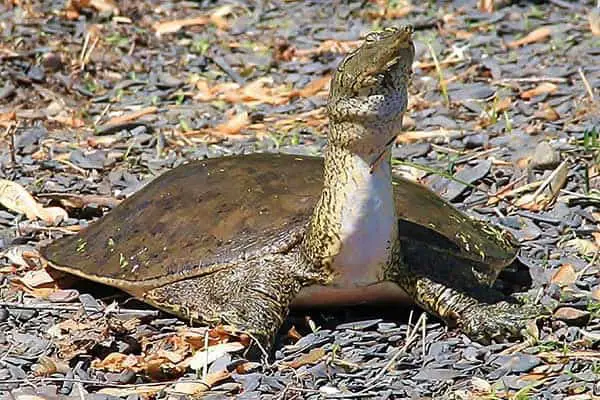
Follow these tips to come up with a suitable habitat for your softshell turtle:
Proper tank size
As we mentioned earlier, Florida softshell turtles grow to pretty big sizes so they require a large housing. A typical female adult will reach over 40 pounds in weight and reach a maximum size of up to 24 inches.
For this reason, you should get your pet a pretty large aquarium or tank of between 75 gallons and 100 gallons. This will ensure they have plenty of area for swimming and roaming around.
Water quality
The water you put in your turtle’s enclosure should stay clean at all times. Otherwise, dirty water encourages turtle fungal and bacterial infections.
Florida softshell turtles are messy, so you should install a canister or submersible filter into their tank.
This helps keep their tank and saves you from the hassle of cleaning the tank and doing water changes more often.
Basking area
You should also provide your Florida softshell pet turtle with a basking area where it can take a break from swimming and dry off its shell as well as soak in the UV rays. Ensure the basking area is stable and spacious enough to accommodate your pet comfortably.
Substrate
The softshells in the wild are fond of burrowing themselves in mud and sand.
Lining their tank bottom with clean sand to play with will help make the tank make feel more natural to them and encourage their natural behavior.
However, putting anything sharp or rough substrates, e.g. gravel, that may easily injure your pet’s fragile softshell.
Temperature
A good habitat for this turtle should also maintain correct temperatures.
The recommended water temperature for this species is around 70 to 80 degrees Fahrenheit. The basking area temperature should be kept around 90 degrees.
You can use a water heater and a heat lamp to help you maintain the water and basking area temperature respectively.
Lighting
Like all the other turtle species, softshells also require exposure to the sun’s UV rays to enable them to produce the Vitamin D3 needed for proper calcium metabolism.
Installing a UVB light-emitting lamp will help provide your pet with these crucial UVB rays.
Keep the light on for around 12 hours daily to help mimic the natural day-night cycle in your turtle’s habitat. You should also replace the UV bulb every 6-9 months as they decay over time.
Florida softshell turtle diet
While in the wild, Florida softshell turtles are highly carnivorous and feed on various insects, fish, eggs, and amphibians out there.
The turtles are also carnivorous in captivity, though they easily adapt to eating turtle pellets as well.
That said, you should feed your pet turtle with a diet that includes gut-loaded crickets, fish, worms, or any other prey that’s generally fed to softshell turtles.
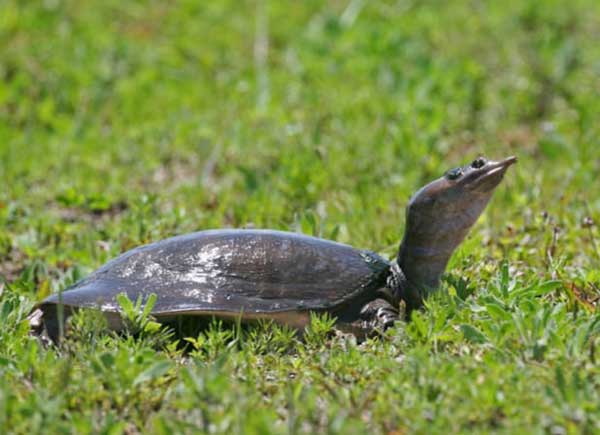
Place the food in the water so your turtle can feed in it without necessarily getting out of the pool. Turtles also need to dehydrate, so you should provide them with a bowl of clean water.
As for the feeding frequency, we recommend feeding your adult turtle once daily as much food as it can consume in about 15 minutes.
TIP: Consult your vet about the right amount of food and the timing for feeding it.
Florida softshell turtle aggressiveness
The turtle is highly vulnerable to predators in the wild due to the lack of a hard shell that offers protection against predators.
For this reason, the turtle must be aggressive to defend itself from potential predators.
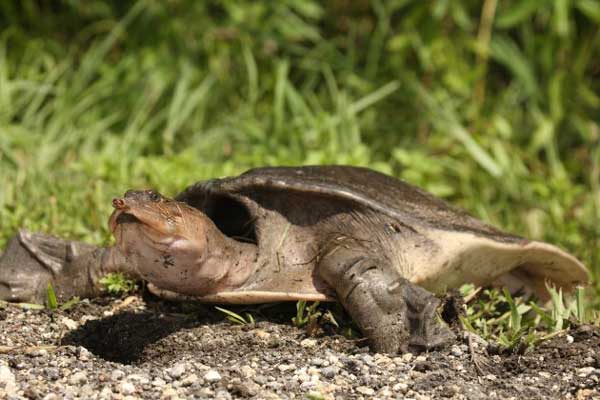
It carries the same aggressiveness with it when you house it indoors. The turtle has strong jaws and sharp claws that can cause serious injuries to your little kids as well as curious pets such as dogs, cats, etc.
It’s also worth noting that these turtles don’t like being handled and will be quick to attack if it feels threatened.
Florida softshell turtle common health problems
The most common health-related issue faced by Florida softshell turtles is high vulnerability to injuries due to the lack of a hard carapace.
It’s quite common to find a softshell turtle with wounds and even infections resulting from the wound.
Also, these turtles suffer from intestinal parasites and ear infections.
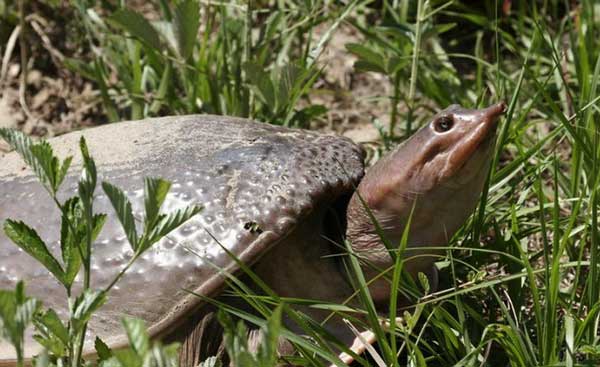
We recommend taking your pet turtle for annual checkups with your vet. An experienced vet should take your pet through diagnosis to check for parasites that are notorious for weakening a turtle’s immune system and its overall health.
In addition to regular vet care, you should also make sure your turtle has a proper tank setup, quality water, and a balanced diet. All these are key to keeping your turtle healthy.
Lifespan in captivity
If you’re interested in keeping a softshell turtle, you’d also be interested in knowing its lifespan in captivity.
Florida softshell turtles can live for many years with proper care. The average lifespan of this species of turtle in captivity is 20 to 30 years. Some can even go for longer-up to 35-plus years—or more with proper care.
keep in mind that the life expectancy of these turtles can be affected by factors like poor water quality, incorrect temperatures, and poor diets.
In other words, poor husbandry towards your pet turtle will greatly affect its lifespan.
Florida softshell turtle baby care
If you have got a Florida softshell baby turtle, you may be wondering how to take good care of it.
The care for a baby turtle isn’t much different from that of an adult turtle we’ve discussed above.
Provide your pet with a small enclosure (around 20 gallons for one baby turtle will work). Set up the tank similar to that of an adult—with a basking spot, UV lighting, heat source, and filter system.
The tank water should be maintained at a temperature of 70 to 80 degrees F while the basking area temperature should be at 90 degrees F.
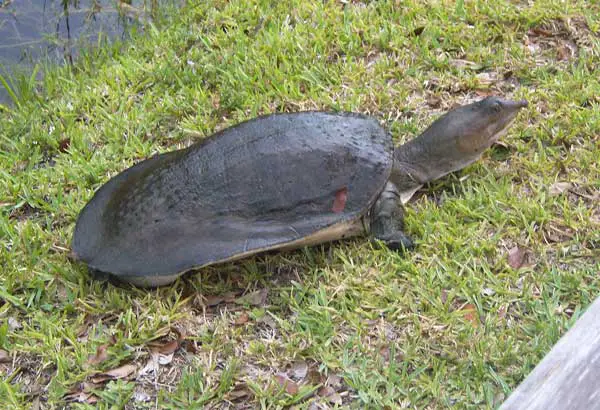
Avoid putting any sharp objects in its tank that may injure its shell and cause wounds that result in infections.
You should give your baby turtle a carnivorous diet. Consider foods such as insects, dead fish, worms fish eggs, small fish, newborn crawdads, etc.
Make sure you closely monitor your pet’s growth. And remember to give it regular vet care to keep its health in check.
Final Verdict
That’s all you need to know about taking care of your Florida softshell turtle. Before you own this type of turtle, you should learn how to take good care of it. The above guide has just disused everything you need to know about giving your turtle the best care and ensuring it leads a happy and healthy life.
Provide your turtle with a spacious enclosure with a basking spot, UV light, a heat source, and a filtration system. Feed the turtle a proper diet, and take it to your vet for a routine checkup to keep away illnesses that affect its health. With proper care, your pet turtle can last for up to 30+ years
